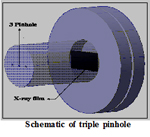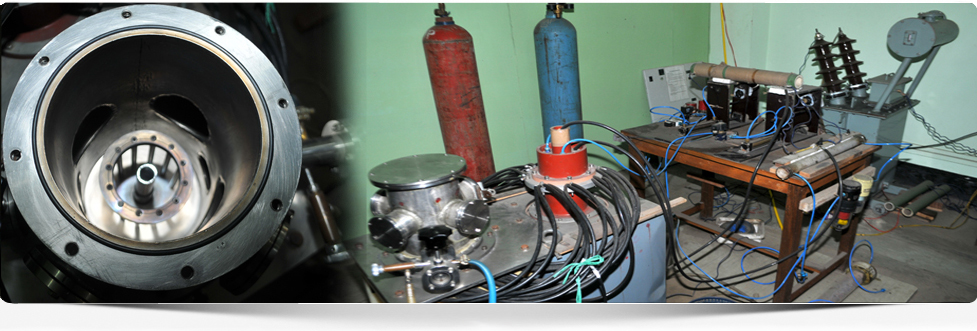 |
 |
 |
|
Pulsed Power Technology Laboratory
|
Dense Plasma Focus Laboratory II
We are engaged in developing and studying vacuum photodiode (VPD) for plasma focus device. This detector is a two-electrode system that works on the principle of photoelectric effect and suitable to use in high vacuum (< 10-5 mb) generally. We have designed and fabricated suitable types of VPDs with aluminum photocathode for the detection of X-ray emitted from PF device. This work has an importance as since VPD is considered to be one of the probable X-ray detectors for ITER.
A qualitative study on the performance of cylindrical vacuum photodiodes (VPDs) for detection of x-ray from plasma focus (PF) device has been carried out. Various parameters of VPD such as electrode’s diameter, electrode’s separation, and its sensitivity are experimentally tested in PF environment. For the first time it is found experimentally that the electrode-separation in the lateral direction of the two coaxial electrodes of cylindrical VPD also plays an important role to increase the efficiency of the detector. Based on this condition we have developed a very small VPD. The details of this developmental work can be found in “Rev. Sci. Instrum., 82, 103507 (2011)”. The study on the VPD as a diagnostics is still going on.
The pinhole based X-ray imaging camera is an efficient and cost effective as well as simple device to study space resolved X-ray emitting zone of dense hot pinched plasma of PF device. It gives over all idea of the location of the X-ray emitting zone as well as approximate size and qualitative idea of radiation density of the X-ray emitting plasma column. The introduction of multiple pinholes in the pinhole camera will help to capture the image of pinched plasma column of PF device in a single shot with multiple filters of different thickness.
Thus, an X-ray pinhole camera that capable of capturing three images simultaneously of the same object was fabricated and employed to capture X-ray emitting zone of PF device.

The effect of anode shape on pinch structure of PF device operated with four anodes of different tip shape namely cylindrical, diverging, oval and converging were studied by employing a triple X-ray pinhole camera. In addition to triple pinhole camera, p-i-n diode X-ray spectrometer has been used to see the effect of anode shape on pinch formation.
We are executing our experiment to estimate the no of neutron emission from PF device by using bubble dosimeter (BD) from Bubble Tech, Inc Canada. The neutron emission found to be higher in the 0.3–0.4 Torr (Mcleod Gauge reading). The number of bubble forms found to be not same in the axial and radial direction. This indicates that the neutron emission is not isotropic in our case also. The work is continuing for further studies.
We have already started the studies on neutron emission from PF device. Now, the careful observations are going on neutron emission and its correlation with X-rays and ions with different shape anode tips (namely cylindrical, diverging, oval and converging tip). Performance of Vacuum photodiode in neutron environment will be investigated in coming days.
|
- “Detection efficiency vs. cathode anode seperation in cylindrical vacuum photodiodes used for measuring x-rays from plasma focus device” by T. K. Borthakur, N. Talukdar, N. K. Neog, C. V. S. Rao, and A. Shyam, published in Review of scientific instrument, 2011
- ‘Studies on X-ray and neutron emission from 2.2 kJ plasma focus device’ by N. Talukdar, T. K. Borthakur , N. K. Neog. accepted to “PROBLEMS OF ATOMIC SCIENCE AND TECHNOLOGY”
|
 |
- “Effect of anode shape on pinch structure of plasma focus device” by N. Talukdar, N.K. Neog and T. K. Borthakur (Communicated)
- “Study of X-ray emission from plasma focus device using vacuum photodiode” N Talukdar, T K Borthakur and N K Neog (Communicated)
- Dr. T. K. Borthakur Alushta (Crimea), Ukraine to attend “International Conference & School on Plasma Physics and Controlled Fusion and The Adjoint Workshop Nano- and micro-sized tructures in plasmas” from September 17-22, 2012 and present a paper on ‘Studies on X-ray and neutron emission from 2.2 kJ plasma focus device’ by N. Talukdar, T. K. Borthakur , N. K. Neog
- Dr. N. K. Neog visited Italy to attend School and Training Course on Dense Magnetized Plasma as a source of ionizing radiations, their diagnostics and applications, ICTP, from October 8-12, 2012 and present a paper on ‘Studies on X-rays and Charged Particles Radiations from Plasma focus device’ by N.Talukdar, N. K. Neog, T. K. Borthakur and S. R. Mohanty
-
“Imaging of X-Ray emitting zone of plasma focus device by simple triple pinhole camera by N. Talukdar, N. K. Neog and T. K. Borthakur, presented in 27th National Symposium on Plasma Science and Technology held at Pondicherry University, Pondicherry from December 10-13, 2012
|
| |
|
| |
|
|


